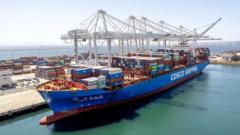The Trump administration has taken a significant step in its ongoing trade confrontation with China, proposing to impose port fees on vessels from the Asian nation. This initiative aims to bolster American shipbuilding and mitigate China's prevailing role in the global maritime industry.
The announcement from the U.S. Trade Representative (USTR) is less stringent compared to earlier suggestions that included steep fees of up to $1.5 million for each Chinese vessel docking at U.S. ports. Instead, these new charges are slated to begin in 180 days, gradually escalating in subsequent years.
Concerns have been raised regarding the potential repercussions these fees might have on global trade, continuing the trend initiated by President Trump’s broader tariff policies. According to a USTR statement, "China has largely achieved its dominance goals, placing U.S. companies, workers, and the economy at a disadvantage."
The port fees for Chinese-owned vessels will depend on various factors such as cargo weight and the number of containers or vehicles onboard. For bulk carriers, the fee will start at $50 per ton of cargo and will rise by $30 annually for the following three years. Container ships will incur initial charges of $18 per ton or $120 per container, both subject to the same increment. Additionally, non-U.S. ships transporting vehicles will face a fee of $150 per vehicle.
It's important to note that the fees will be assessed once per voyage, capped at five occurrences a year. Certain exemptions apply, including empty vessels bound for U.S. ports for bulk exports, ships operating between American ports, and Canadian vessels cruising the Great Lakes.
Looking ahead, the USTR has indicated that in three years, a second phase will commence, targeting U.S.-constructed vessels ferrying liquified natural gas (LNG), with new restrictions anticipated to ascend over a staggering 22-year period.
This latest development comes in a context where global trading patterns are already in flux due to Trump's earlier tariff measures. The trade group noted that shipments intended for U.S. ports from China are increasingly being rerouted to European destinations—a trend that could exacerbate domestic market prices.
Additionally, U.S. tariffs have been undergone significant inflation, reaching rates as high as 245% on some goods from China. This rise in tariffs has reportedly led to increased shipping congestion in major global ports, including significant bottlenecks in the EU and the UK, where trade organizations note a shift of cargo from China to these markets.
Experts have voiced concerns that as more shipments are routed towards Europe in response to U.S. tariff increases, congestion in European ports will intensify, thereby inflating prices for consumers globally. This dynamic has prompted a re-evaluation of supply chains and where goods are sourced, further affecting international business operations.




















